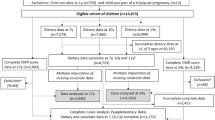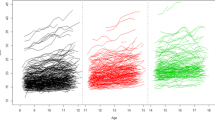Abstract
Purpose
To prospectively examine the relation between adolescent dietary intake and cardiometabolic risk (CMR) clustering at the end of adolescence.
Methods
Data from the NHLBI Growth and Health Study on 1369 girls enrolled at ages 9–10 in 1987–1988 and followed for 10 years were used to estimate the relative risk of having multiple (≥2 or ≥3) risk factors in late adolescence associated with usual food intake patterns from 9 to 17 years of age. Mean food intakes were derived from multiple 3-day diet records and CMR factors included larger waist circumference, insulin resistance, low high-density lipoprotein cholesterol, high low-density lipoprotein cholesterol, high triglycerides, and elevated systolic or diastolic blood pressures.
Results
Of 1369 subjects, 18.4 % girls had 3–6 prevalent risk factors by the end of adolescence and 35.0 % had at least two. Higher intakes of fruit and non-starchy vegetables, dairy, and grains were independently associated with having fewer risk factors as were eating patterns characterized by higher combined intakes of these food groups. After adjusting for age, race, socio-economic status, height, physical activity, and television watching, girls with high intakes of dairy and fruits and non-starchy vegetables (vs. those with lower intakes of both) were nearly 50 % less likely to have three or more CMR factors in late adolescence; girls with higher intakes of grains plus fruits and non-starchy vegetables were nearly 60 % less likely.
Conclusion
These results suggest that healthy food consumption patterns during adolescence may prevent accumulation of cardiometabolic risk.
Similar content being viewed by others
References
Camhi SM, Katzmarzyk PT (2010) Tracking of cardiometabolic risk factor clustering from childhood to adulthood. Int J Pediatr Obes 5:122–129
Hakanen M, Lagstrom H, Pahkala K, Sillanmaki L, Saarinen M, Niinikoski H, Raitakari OT, Viikari J, Simell O, Ronnemaa T (2010) Dietary and lifestyle counselling reduces the clustering of overweight-related cardiometabolic risk factors in adolescents. Acta Paediatr 99:888–895
Shah AS, Dolan LM, Gao Z, Kimball TR, Urbina EM (2011) Clustering of risk factors: a simple method of detecting cardiovascular disease in youth. Pediatrics 127:e312–e318
Djousse L, Padilla H, Nelson TL, Gaziano JM, Mukamal KJ (2010) Diet and metabolic syndrome. Endocr Metab Immune Disord Drug Targets 10:124–137
Berg CM, Lappas G, Strandhagen E, Wolk A, Toren K, Rosengren A, Aires N, Thelle DS, Lissner L (2008) Food patterns and cardiovascular disease risk factors: the Swedish INTERGENE research program. Am J Clin Nutr 88:289–297
Crichton GE, Bryan J, Buckley J, Murphy KJ (2011) Dairy consumption and metabolic syndrome: a systematic review of findings and methodological issues. Obes Rev 12:e190–e201
Feldeisen SE, Tucker KL (2007) Nutritional strategies in the prevention and treatment of metabolic syndrome. Appl Physiol Nutr Metab 32:46–60
Bel-Serrat S, Mouratidou T, Bornhorst C, Peplies J, De HS, Marild S, Molnar D, Siani A, Tornaritis M, Veidebaum T, Krogh V, Moreno LA (2012) Food consumption and cardiovascular risk factors in European children: the IDEFICS study. Pediatr Obes 8:225–236
Berz JP, Singer MR, Guo X, Daniels SR, Moore LL (2011) Use of a DASH food group score to predict excess weight gain in adolescent girls in the national growth and health study. Arch Pediatr Adolesc Med 165:540–546
Moore LL, Bradlee ML, Singer MR, Qureshi MM, Buendia JR, Daniels SR (2012) Dietary approaches to stop hypertension (DASH) eating pattern and risk of elevated blood pressure in adolescent girls. Br J Nutr 108:1678–1685
Bradlee ML, Singer MR, Daniels SR, Moore LL (2013) Eating patterns and lipid levels in older adolescent girls. Nutr Metab Cardiovasc Dis 23:196–204
Obarzanek E, Schreiber GB, Crawford PB, Goldman SR, Barrier PM, Frederick MM, Lakatos E (1994) Energy intake and physical activity in relation to indexes of body fat: the National Heart, Lung, and Blood Institute Growth and Health Study. Am J Clin Nutr 60:15–22
Schakel SF, Sievert YA, Buzzard IM (1988) Sources of data for developing and maintaining a nutrient database. J Am Diet Assoc 88:1268–1271
Cook A, Friday J (2004) Pyramid Servings Database for USDA Survey Food Codes Version 2.0 Beltsville, MD: USDA, Agricultural Research Service, Community Nutrition Research Group. http://www.barc.usda.gov/bhnrc/cnrg
Friedewald WT, Levy RI, Fredrickson DS (1972) Estimation of the concentration of low-density lipoprotein cholesterol in plasma, without use of the preparative ultracentrifuge. Clin Chem 18:499–502
Matthews DR, Hosker JP, Rudenski AS, Naylor BA, Treacher DF, Turner RC (1985) Homeostasis model assessment: insulin resistance and beta-cell function from fasting plasma glucose and insulin concentrations in man. Diabetologia 28:412–419
Kimm SY, Glynn NW, Kriska AM, Fitzgerald SL, Aaron DJ, Similo SL, McMahon RP, Barton BA (2000) Longitudinal changes in physical activity in a biracial cohort during adolescence. Med Sci Sports Exerc 32:1445–1454
National Cholesterol Education Program (2001) Executive summary of the third report of The National Cholesterol Education Program (NCEP) expert panel on detection, evaluation, and treatment of high blood cholesterol in adults (adult treatment panel III). JAMA 285:2486–2497
Zimmet P, Alberti KG, Kaufman F, Tajima N, Silink M, Arslanian S, Wong G, Bennett P, Shaw J, Caprio S (2007) The metabolic syndrome in children and adolescents—an IDF consensus report. Pediatr Diabetes 8:299–306
National High Blood Pressure Education Program Working Group on Hypertension Control in Children and Adolescents (1996) Update on the 1987 task force report on high blood pressure in children and adolescents: a working group report from the National High Blood Pressure Education Program. Pediatrics 98:649–658
American Academy of Pediatrics (1992) National Cholesterol Education Program: report of the expert panel on blood cholesterol levels in children and adolescents. Pediatrics 89:525–584
Ascaso JF, Romero P, Real JT, Lorente RI, Martinez-Valls J, Carmena R (2003) Abdominal obesity, insulin resistance, and metabolic syndrome in a southern European population. Eur J Intern Med 14:101–106
Bel-Serrat S, Mouratidou T, Jimenez-Pavon D, Huybrechts I, Cuenca-Garcia M, Mistura L, Gottrand F, Gonzalez-Gross M, Dallongeville J, Kafatos A, Manios Y, Stehle P, Kersting M, De HS, Castillo M, Hallstrom L, Molnar D, Widhalm K, Marcos A, Moreno LA (2014) Is dairy consumption associated with low cardiovascular disease risk in European adolescents? Results from the HELENA Study. Pediatr Obes 9:401–410
Ambrosini GL, Huang RC, Mori TA, Hands BP, O’Sullivan TA, de Klerk NH, Beilin LJ, Oddy WH (2010) Dietary patterns and markers for the metabolic syndrome in Australian adolescents. Nutr Metab Cardiovasc Dis 20:274–283
Pan Y, Pratt CA (2008) Metabolic syndrome and its association with diet and physical activity in US adolescents. J Am Diet Assoc 108:276–286
Kelishadi R, Gouya MM, Adeli K, Ardalan G, Gheiratmand R, Majdzadeh R, Mahmoud-Arabi MS, Delavari A, Riazi MM, Barekati H, Motaghian M, Shariatinejad K, Heshmat R (2008) Factors associated with the metabolic syndrome in a national sample of youths: CASPIAN Study. Nutr Metab Cardiovasc Dis 18:461–470
Holt EM, Steffen LM, Moran A, Basu S, Steinberger J, Ross JA, Hong CP, Sinaiko AR (2009) Fruit and vegetable consumption and its relation to markers of inflammation and oxidative stress in adolescents. J Am Diet Assoc 109:414–421
Yoo S, Nicklas T, Baranowski T, Zakeri IF, Yang SJ, Srinivasan SR, Berenson GS (2004) Comparison of dietary intakes associated with metabolic syndrome risk factors in young adults: the Bogalusa Heart Study. Am J Clin Nutr 80:841–848
Pereira MA, Jacobs DR Jr, Van Horn L, Slattery ML, Kartashov AI, Ludwig DS (2002) Dairy consumption, obesity, and the insulin resistance syndrome in young adults: the CARDIA Study. JAMA 287:2081–2089
Houston MC, Harper KJ (2008) Potassium, magnesium, and calcium: their role in both the cause and treatment of hypertension. J Clin Hypertens 10:3–11
Rolls BJ, Ello-Martin JA, Tohill BC (2004) What can intervention studies tell us about the relationship between fruit and vegetable consumption and weight management? Nutr Rev 62:1–17
Marlett JA, McBurney MI, Slavin JL (2002) Position of the American Dietetic Association: health implications of dietary fiber. J Am Diet Assoc 102:993–1000
Berkey CS, Rockett HR, Willett WC, Colditz GA (2005) Milk, dairy fat, dietary calcium, and weight gain: a longitudinal study of adolescents. Arch Pediatr Adolesc Med 159:543–550
Louie JC, Flood VM, Hector DJ, Rangan AM, Gill TP (2011) Dairy consumption and overweight and obesity: a systematic review of prospective cohort studies. Obes Rev 12:e582–e592
Spence LA, Cifelli CJ, Miller GD (2011) The role of dairy products in healthy weight and body composition in children and adolescents. Curr Nutr Food Sci 7:40–49
Luhovyy BL, Akhavan T, Anderson GH (2007) Whey proteins in the regulation of food intake and satiety. J Am Coll Nutr 26:704S–712S
Kris-Etherton PM, Grieger JA, Hilpert KF, West SG (2009) Milk products, dietary patterns and blood pressure management. J Am Coll Nutr 28(Suppl 1):103S–119S
Steffen LM, Jacobs DR Jr, Murtaugh MA, Moran A, Steinberger J, Hong CP, Sinaiko AR (2003) Whole grain intake is associated with lower body mass and greater insulin sensitivity among adolescents. Am J Epidemiol 158:243–250
Bradlee ML, Singer MR, Qureshi MM, Moore LL (2010) Food group intake and central obesity among children and adolescents in the Third National Health and Nutrition Examination Survey (NHANES III). Public Health Nutr 13:797–805
Newby PK, Peterson KE, Berkey CS, Leppert J, Willett WC, Colditz GA (2003) Dietary composition and weight change among low-income preschool children. Arch Pediatr Adolesc Med 157:759–764
Williams PG (2012) Evaluation of the evidence between consumption of refined grains and health outcomes. Nutr Rev 70:80–90
Berenson GS, Srinivasan SR, Bao W, Newman WP III, Tracy RE, Wattigney WA (1998) Association between multiple cardiovascular risk factors and atherosclerosis in children and young adults. The Bogalusa Heart Study. N Engl J Med 338:1650–1656
Kelly AS, Steinberger J, Jacobs DR, Hong CP, Moran A, Sinaiko AR (2011) Predicting cardiovascular risk in young adulthood from the metabolic syndrome, its component risk factors, and a cluster score in childhood. Int J Pediatr Obes 6:e283–e289
Acknowledgments
This manuscript uses previously collected “NHLBI Growth and Health Study” research data obtained from the National Heart Lung and Blood Institute. The analyses were supported by Grant No. R21DK075068 from the National Institute of Diabetes and Digestive and Kidney Diseases (NIDDK) and a grant from the National Dairy Council.
Conflict of interest
The authors declare no conflict of interest.
Author information
Authors and Affiliations
Corresponding author
Rights and permissions
About this article
Cite this article
Moore, L.L., Singer, M.R., Bradlee, M.L. et al. Adolescent dietary intakes predict cardiometabolic risk clustering. Eur J Nutr 55, 461–468 (2016). https://doi.org/10.1007/s00394-015-0863-8
Received:
Accepted:
Published:
Issue Date:
DOI: https://doi.org/10.1007/s00394-015-0863-8




